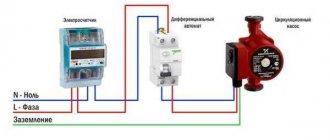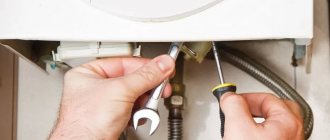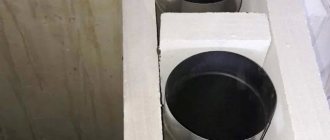When working on semi-automatic welding machines, filler wire is used, which does not contain protective substances. As a result, the seam is subject to oxidation from atmospheric oxygen. This phenomenon will subsequently lead to the appearance of microcracks, as well as destruction of the connection. To prevent the negative effects of foreign substances, gas is used for semi-automatic welding. The protective environment allows you to connect any types of metals by welding.
Semi-automatic device with gas cylinder
Some repair features
Many years of experience show that in some cases the weld is weak due to the poor quality of the shielding gas.
Or due to its unstable supply to the arc burning zone.
In such cases, it is necessary to inspect the entire gas supply path and the burner, which the welder holds with his own hands during work.
This tool should always be kept in working order. Protect it from damage and contamination.
All preventive maintenance prescribed in the operating instructions must be carried out strictly.
If these requirements are met, the semi-automatic welding machine will operate flawlessly.
Cooling method
Burner cooling can be air or liquid. For currents up to 250 A, air cooling is sufficient. With such a tool it is easy to make short seams without fear of overheating.
For long seams, high loads and large volumes of work, liquid-cooled torches are relevant. They provide additional channels for supplying and discharging liquid. The working fluid is supplied from a special cooling module to which the burner is connected. It is unsafe to operate such burners without liquid.
Repair of inverter welding machines
The design of welding inverters uses high-frequency electronics, which, unfortunately, not only significantly increases the performance and functionality of the device, but also often becomes capricious.
Where to start repairing a welding inverter?
Repair of inverter welding machines - regardless of the manufacturer and model - begins with a banal “opening” of the equipment and an external inspection of the “internals”. Perhaps already at this stage you will be lucky and you will be able to “calculate” the failed part by its appearance. If at first glance everything looks as usual, proceed to diagnosis.
Diagnostics and repair
The first step is to check the fuses located on the control board. After dismantling the board, determine the broken element with a tester or ohmmeter, carefully replace it and reassemble the inverter. If all the fuses are working, the problem may be the faults described below in the circuit.
Often repair of a welding inverter is required as a result of a breakdown
field-effect transistors, which are the “weak link”. External signs of failure, which were mentioned in the previous paragraph, practically do not appear in these elements. A cracked case and melted leads are extremely rare occurrences. It is for this reason that burnt transistors can only be found by testing them sequentially with a multimeter.
The next stage of diagnostics is checking the driver elements that control the operation of field-effect transistors. Failed elements can be identified using an ohmmeter.
A little advice: in order not to get confused, ring both transistors and driver elements according to the diagram of your inverter welding machine, having previously chosen the direction (for example, from left to right). Then the risk of missing something or forgetting about any element will simply disappear.
If the breakdown is still not detected, we complete the diagnosis by checking the main parts of the rectifiers (we are talking about diode bridges). They, being the most reliable elements of an inverter welding machine, break down extremely rarely, but it is still worth taking into account the likelihood of failure. In order to diagnose the diodes installed on the radiators, you should first remove them from the board. The resistance of a good diode changes from “+” to “-” and vice versa. The rest are mercilessly thrown away.
Repair of inverter welding machines when the breakdowns described above are identified consists of replacing the elements that “failed”.
Some tips for repairing welding inverters
- Transistors often fail due to overheating. So once you get to the inside of the device, just in case, change the thermal paste at the point of contact with the heat sink plate.
- Even if the breakdown is fixed, take a look at all the contacts. Clean up and reconnect the ones that don't look very nice.
Care and operation of gas burners
Be sure to clean the nozzle after each use. Drops of metal should be cleaned off. Since during subsequent work they can interfere with high-quality soldering.
Pay close attention to the contact elements to avoid burnout.
Monitor the formation of an oxide film and remove it in time, or change the elements.
The technical data sheet contains a list of elements that come in the additional kit. It wouldn't hurt to purchase these parts additionally.
How to make a spot welding machine - how to assemble the machine at home with your own handsHow to assemble a simple welding machine at home: drawings of inverter models and step-by-step assembly instructions
Do-it-yourself welding table - step-by-step instructions for manufacturing and assembly (65 photos)
Setting the wire feed speed
p, blockquote 10,0,0,0,0 –>
- The wire feed speed controller also serves another purpose - it regulates the current. Voltage and current are related and, to some extent, are based on the size of the wire and its speed. In a semi-automatic machine, the set voltage remains unchanged, but the current varies slightly depending on the wire feed speed and the electrode (wire) stick out. Thus, the faster the wire is fed to the welding site, the greater the current strength and the higher the welding temperature, but for a specific, established type of voltage this is only a small range of changes in current strength.
- The wire outside the welding process (without an electric arc) moves faster. When an arc is formed, the speed of the wire decreases.
- How do I know if my wire feed settings are correct? To do this you need to try welding. If the speed is too high for your voltage setting, the wire will bend when it touches the metal before it has time to melt, and there will be a lot of spatter. If the speed is too slow for your voltage setting, the wire will burn before it touches the metal and the tip will clog. Thus, if the wire feed speed is incorrectly set, welding will not work at all. This parameter must be adjusted experimentally. It is important to set the correct voltage for the specific thickness of the metal being welded and try welding, and adjust the wire feed speed during the process.
Semi-automatic welding machine: operating principle
In order not to “kill” the device when using a semi-automatic welding machine. To avoid injury, you should know about the safety rules and the operating principle of the device.
The semiautomatic welding machine consists of:
- housing containing a powerful transformer;
- hose for supplying current and gas to the burner;
- cables for connecting to ground and the electrical network;
- wire feed mechanism.
Also, for semi-automatic welding, you will need to purchase a reel with a special welding wire and a cylinder of carbon dioxide.
The operating principle of the semi-automatic device is as follows:
- The welding current is supplied to the torch simultaneously with the shielding gas.
- The torch uses a welding wire as an electrode, which is fed automatically using a special mechanism.
- An electric arc is formed between the product being welded and the wire, which melts the metal in a protective gas environment, which allows you to obtain a high-quality weld without oxides.
The basic safety rules when working with semi-automatic welding machines are as follows:
- the body of the welding machine must be grounded;
- it is prohibited to use the device even with minor mechanical damage or any other malfunctions;
- in case of significant interruptions in work, be sure to disconnect the device from the electrical network and turn off the supply of protective gas;
- do not work near flammable and explosive substances;
- Use a protective mask and gloves while working.
As soon as the basic principles of working with a semi-automatic machine are mastered, you can begin practical work.
Gas distribution nozzles
The nozzles are designed to distribute the gas flow evenly and to protect the welding tip from damage. Nozzle diameters from 9.5 mm to 19 mm are available.
Article: 071.500.190 Nozzle d19mm (MIG MP 26/400/500) SVO2619
A gas distribution nozzle with a diameter of 19 mm is installed on a MIG welding torch and serves to uniformly distribute the gas flow, as well as to protect the welding tip from mechanical impact or accidental contact with the product being welded. Suitable for MP 36/400/500 series burners.
Price: 314 RUR
Article: 071.500.160 Nozzle d16mm (MIG MP 26/400/500) SVO2616
A gas distribution nozzle with a diameter of 16 mm is installed on a MIG welding torch and serves to uniformly distribute the gas flow, as well as to protect the welding tip from mechanical impact or accidental contact with the product being welded. Suitable for MP 26/400/500 series burners.
Price: 314 RUR
Article: 071.500.140 Nozzle d14mm (MIG MP 26/400/500) SVO2614
A gas distribution nozzle with a diameter of 14 mm is installed on a MIG welding torch and serves to uniformly distribute the gas flow, as well as to protect the welding tip from mechanical impact or accidental contact with the product being welded. Suitable for MP 26/400/500 series burners.
Price: 314 RUR
Article: 071.360.190 Nozzle d19mm (MIG MP 36) SVO3619
A gas distribution nozzle with a diameter of 19 mm is installed on a MIG welding torch and serves to uniformly distribute the gas flow, as well as to protect the welding tip from mechanical impact or accidental contact with the product being welded. Suitable for MP 36 series burners.
Price: 295 RUR
Article: 071.360.160 Nozzle d16mm (MIG MP 36) SVO3616
A gas distribution nozzle with a diameter of 16 mm is installed on a MIG welding torch and serves to uniformly distribute the gas flow, as well as to protect the welding tip from mechanical impact or accidental contact with the product being welded. Suitable for MP 36 series burners.
Price: 295 RUR
Article: 071.360.120 Nozzle d12mm (MIG MP 36) SVO3612
A gas distribution nozzle with a diameter of 12 mm is installed on a MIG welding torch and serves to uniformly distribute the gas flow, as well as to protect the welding tip from mechanical impact or accidental contact with the product being welded. Suitable for MP 36 series burners.
Price: 295 RUR
Article: 071.250.180 Nozzle d18mm (MIG MP 25) SVO2518
A gas distribution nozzle with a diameter of 18 mm is installed on a MIG welding torch and serves to uniformly distribute the gas flow, as well as to protect the welding tip from mechanical impact or accidental contact with the product being welded. Suitable for MP 25 series burners.
Price: 168 RUR
Article: 071.250.150 Nozzle d15mm (MIG MP 25) SVO2515
A gas distribution nozzle with a diameter of 15 mm is installed on a MIG welding torch and serves to uniformly distribute the gas flow, as well as to protect the welding tip from mechanical impact or accidental contact with the product being welded. Suitable for MP 25 series burners.
Price: 168 RUR
Article: 071.250.110 Nozzle d11mm (MIG MP 25) SVO2511
A gas distribution nozzle with a diameter of 11 mm is installed on a MIG welding torch and serves to uniformly distribute the gas flow, as well as to protect the welding tip from mechanical impact or accidental contact with the product being welded. Suitable for MP 25 series burners.
Price: 168 RUR
Article: 071.240.170 Nozzle d17mm (MIG MP 24/240) SVO2417
A gas distribution nozzle with a diameter of 17 mm is installed on a MIG welding torch and serves to uniformly distribute the gas flow, as well as to protect the welding tip from mechanical impact or accidental contact with the product being welded. Suitable for MP 24/240 series burners.
Price: 170 RUR
Article: 071.240.125 Nozzle d12mm (MIG MP 24/240) SVO2412
A gas distribution nozzle with a diameter of 12 mm is installed on a MIG welding torch and serves to uniformly distribute the gas flow, as well as to protect the welding tip from mechanical impact or accidental contact with the product being welded. Suitable for MP 24/240 series burners.
Price: 170 RUR
Article: 071.240.100 Nozzle d10mm (MIG MP 24/240) SVO2410
A gas distribution nozzle with a diameter of 10 mm is installed on a MIG welding torch and serves to uniformly distribute the gas flow, as well as to protect the welding tip from mechanical impact or accidental contact with the product being welded. Suitable for MP 24/240 series burners.
Price: 170 RUR
Article: 071.150.160 Nozzle d16mm (MIG MP 15) SVO1516
A gas distribution nozzle with a diameter of 16 mm is installed on a MIG welding torch and serves to uniformly distribute the gas flow, as well as to protect the welding tip from mechanical impact or accidental contact with the product being welded. Suitable for MP 15 series burners.
Price: 108 RUR
Article: 071.150.120 Nozzle d12mm (MIG MP 15) SVO1512
A gas distribution nozzle with a diameter of 12 mm is installed on a MIG welding torch and serves to uniformly distribute the gas flow, as well as to protect the welding tip from mechanical impact or accidental contact with the product being welded. Suitable for MP 15 series burners.
Price: 108 RUR
Article: 071.150.095 Nozzle d9.5mm (MIG MP 15) SVO1595
A gas distribution nozzle with a diameter of 9.5 mm is installed on a MIG welding torch and serves to uniformly distribute the gas flow, as well as to protect the welding tip from mechanical impact or accidental contact with the product being welded. Suitable for MP 15 series burners.
Price: 108 RUR
Polarity when welding semi-automatically
Before welding, you need to decide which polarity you will use.
p, blockquote 11,0,0,0,0 –>
Plain copper-clad wire that is used with shielding gas should be used with reverse polarity when positive is applied to the wire. Straight polarity is used when the semi-automatic machine has flux wire installed, which is used without gas. In this case, a minus is applied to the wire, and a plus is applied to the metal being welded through the terminal. Thus, maximum heat generation is generated on the wire. This is necessary so that the flux in it can work properly.
p, blockquote 12,0,0,0,0 –>
If you use the wrong polarity for a certain electrode (in the case of a semi-automatic wire), then the strength of the weld will be poor. If the wrong polarity is used, there will be a lot of spatter, poor welding penetration and the welding arc will be difficult to control.
p, blockquote 13,1,0,0,0 –>
To change the polarity, you need to open the cover of the semiautomatic device and swap the terminals. Next to the terminals there is a table specifying the order of the terminals.
p, blockquote 14,0,0,0,0 –>
Welding wire
p, blockquote 15,0,0,0,0 –>
The semi-automatic machine can use two types of wires: plain copper-coated wire and flux-coated wire.
p, blockquote 16,0,0,0,0 –>
- Simple wire for semi-automatic welding is used with shielding gas and does not have any additives that can “resist” corrosion and contamination. Therefore, the surface must be prepared carefully.
- The second type of wire has a flux in the center, which, when burned, forms a protective gas. Thus, you can do without a gas cylinder. This wire creates deeper penetration when welding than conventional wire with gas. Flux-cored wire creates a lot of spatter and slag in the welding area, which must be cleaned up after welding is complete. When welding with such wire, minimal surface preparation is required, minor contamination is forgiven. This wire also works well when it's windy outside. For flux-cored welding, the machine must be set to straight polarity (see above).
- The greater the thickness of the metal being welded, the larger the diameter of the wire you need to use, since larger diameter wire conducts more electricity and gives more heat and better penetration.
Automatic shutdown of the welding device
Operation of a semi-automatic welding machine.
In this situation, when connected to the network, a spontaneous shutdown occurs, as the protective element is triggered. Such problems most often occur during the closing of a high voltage circuit. Usually the wires and the housing or the wiring itself are shorted. The protection may operate due to a short circuit between the coil turns or magnetic circuit elements.
Read more: Diode strip for cars
If repairs are necessary, you should disconnect the welding machine from the power supply, locate the source of the problem and correct it - this could be restoring the insulation, replacing the capacitor and other possible malfunctions.
Ganders
Replacing the gander will save the cost of purchasing a new burner in case of mechanical damage to the product.
Article: 071.500.007 Gander (MIG MP 500) VOZ5010
The MIG MP 500 gooseneck is an integral structural part of a semi-automatic welding torch. Connects to the torch handle and extends it for ease of welding. The welding tip and nozzle, as well as other necessary elements, are attached to the gander.
Price: 2,600 rub.
Article: 071.360.007 Gander (MIG MP 36) VOZ3608-01
The MIG MP 36 gooseneck is an integral structural part of a semi-automatic welding torch. Connects to the torch handle and extends it for ease of welding. The welding tip and nozzle, as well as other necessary elements, are attached to the gander.
Price: RUR 1,253
Article: 071.250.007 Gander (MIG MP 25) VOZ2508
The MIG MP 25 gooseneck is an integral structural part of a semi-automatic welding torch. Connects to the torch handle and extends it for ease of welding. The welding tip and nozzle, as well as other necessary elements, are attached to the gander.
Price: 743 RUR
Article: 071.240.007 Gander (MIG MP 24) VOZ2406
The MIG MP 24 gooseneck is an integral structural part of a semi-automatic welding torch. Connects to the torch handle and extends it for ease of welding. The welding tip and nozzle, as well as other necessary elements, are attached to the gander.
Price: RUR 1,116
Article: 071.150.007 Gander (MIG MP 15) VOZ1506
The MIG MP 15 gooseneck is an integral structural part of a semi-automatic welding torch. Connects to the torch handle and extends it for ease of welding. The welding tip and nozzle, as well as other necessary elements, are attached to the gander.
Price: 343 RUR
Why does water in oil cause shooting?
When the temperature reaches 100 degrees, water changes from liquid to gaseous state. It expands greatly. When the heating process proceeds very quickly, expansion also occurs intensely, explosively. The oil can be heated to 160-180 degrees, under such conditions the water evaporates instantly, a drop of it creates a micro-explosion due to a very fast, strong increase in volume. The steam moves the oil violently as it leaves the pan, creating agitation and splatter. The process is relevant for any type of fat used in cooking - for vegetable and animal oils.
Interesting: Why is Christmas on January 7th? Reasons, photos and videos
Getting started with a semi-automatic welding machine
To start working, the semi-automatic welding machine must be completely ready for the welding process. The wire must be installed and the gas cylinder connected. It is necessary to install a ground clamp on the metal being welded. It must be installed at a distance of 15 to 50 cm from the welding zone. The metal must be free of rust, paint, oils and dirt. Any slight resistance will affect the welding process. Dirty metal during welding will cause spatter and burn through, as well as fire.
p, blockquote 18,0,0,0,0 –>
p, blockquote 19,0,0,1,0 –>
Correctly adjusted voltage and wire feed speed should result in good welding flow. The correct settings will produce the characteristic hissing-buzzing sound that all welders know well. More details about the welding process can be found in the article “MIG / MAG semi-automatic welding technology”.
p, blockquote 20,0,0,0,0 –>
Tip inserts
Inserts are used to fix the welding tip.
Article: 071.250.803 Insert for tip M8 25mm (MIG MP 400/500) EGO5025-168
The M8 tip insert for MIG torches is installed on the semi-automatic torch neck and serves to secure the welding tip. The product is made of brass.
Price: 78 rub.
Article: 071.360.803 Insert for tip M8 28mm (MIG MP 36) EGO3628-88
The MIG MP 36 torch tip insert is installed on the semi-automatic torch neck and serves to secure the welding tip. M8 thread. The product is made of brass.
Price: 65 RUR
Article: 071.360.603 Insert for tip M6 28mm (MIG MP 36) EGO3628-86
The MIG MP 36 torch tip insert is installed on the semi-automatic torch neck and serves to secure the welding tip. M6 thread. The product is made of brass.
Price: 65 RUR
Article: 071.240.603 Insert for tip M6 26mm (MIG MP 24/240) EGO2426-66
The tip insert for MIG MP 24/240 torches is installed on the jib of a semi-automatic torch and serves to fix the welding tip. M6 thread. The product is made of brass.
Price: 63 RUR
Article: 071.250.003 Insert for tip M6 35mm (MIG MP 25) EGO2535-86
The tip insert for MIG MP 25 torches is installed on the neck of a semi-automatic torch and serves to fix the welding tip. M6 thread. The product is made of copper.
Price: 77 RUR
Tags
The flux cored wire welds the wire when the wire stopped more than the wire tone of the wire and the wire on which the wire comes from the wire better clamps the wire not a semi-automatic welds in jerks. Does not weld in the environment when trying to weld in a copper-plated shop. cooks even the one you cook when the wire stops on the wire and the wire is not clamped the wire is not clamped
wiremenu large was roller there are tips no try contact person metal became thank you bad bought more generally with jerks pressure set less completely wire channel inside better starts new me share ok understand look connections gearbox changed











